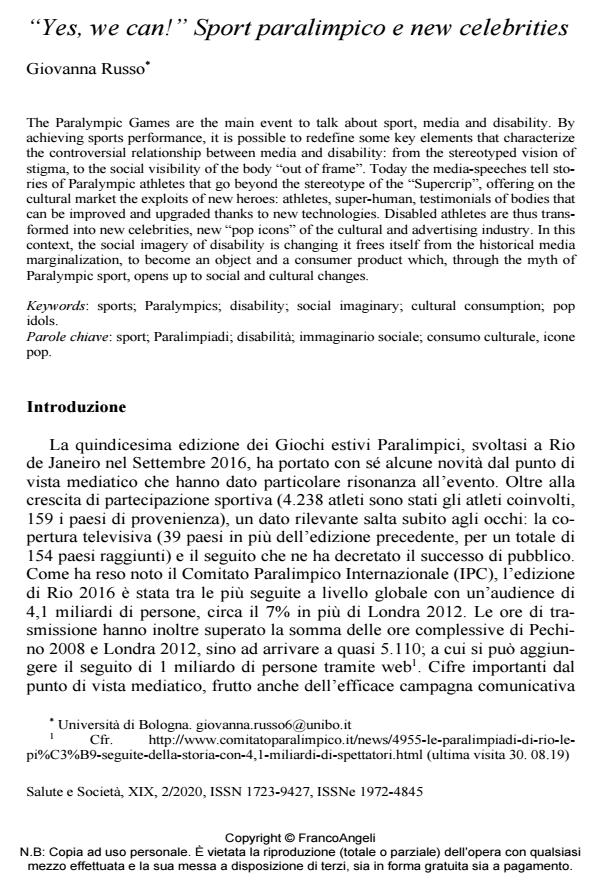"Yes, we can!" Sport paralimpico e new celebrities
Journal title SALUTE E SOCIETÀ
Author/s Giovanna Russo
Publishing Year 2020 Issue 2020/2 Language Italian
Pages 17 P. 104-120 File size 186 KB
DOI 10.3280/SES2020-002008
DOI is like a bar code for intellectual property: to have more infomation
click here
Below, you can see the article first page
If you want to buy this article in PDF format, you can do it, following the instructions to buy download credits

FrancoAngeli is member of Publishers International Linking Association, Inc (PILA), a not-for-profit association which run the CrossRef service enabling links to and from online scholarly content.
The Paralympic Games are the main event to talk about sport, media and disability. Byachieving sports performance, it is possible to redefine some key elements that characterizethe controversial relationship between media and disability: from the stereotyped vision ofstigma, to the social visibility of the body "out of frame". Today the media-speeches tell storiesof Paralympic athletes that go beyond the stereotype of the "Supercrip", offering on thecultural market the exploits of new heroes: athletes, super-human, testimonials of bodies thatcan be improved and upgraded thanks to new technologies. Disabled athletes are thus transformedinto new celebrities, new "pop icons" of the cultural and advertising industry. In thiscontext, the social imagery of disability is changing it frees itself from the historical mediamarginalization, to become an object and a consumer product which, through the myth ofParalympic sport, opens up to social and cultural changes.
Keywords: Sports; Paralympics; disability; social imaginary; cultural consumption; popidols.
- Abercrombie N., Longhurst B. (1998). Audiences: Towards a Theory of Performance and Imagination. London: Sage.
- Barnartt S.N. (2001). Using Role Theory to Describe Disability. In: Barnartt S.N., Altman B.M., eds., Exploring Theories and Expanding methodologies: Where We Are and Where We Need to Go. Oxford: JAI Press.
- Barnes C. (1999). Exploring disability. A sociological introduction. Cambridge: Polity Press.
- Boltansky L. (2000). Lo spettacolo del dolore: morale umanitaria, media e politica. Milano: Cortina.
- Bourdieu P. (1983). La distinzione. Critica sociale del gusto. Bologna: Il Mulino.
- Bourdieu P. (2003). Prefazione. In: Sayad A., ed., La doppia assenza. Dall’illusione dell’emigrato alle sofferenze dell’immigrato. Milano: Cortina.
- Caldin R. (2006). “Disabilità” e “handicap” parole per l’integrazione?. In: Moliterni P., Serio N., a cura di, Qualità della didattica, qualità dell’integrazione. “Dal dire al fare”. Vasto: Ed. Didattiche Gulliver.
- Canevaro A. (1999). Pedagogia speciale. La riduzione dell’handicap. Milano: Mondadori.
- Colombo F. (2018). Imago pietatis. Indagine su fotografia e compassione. Milano: Vita e Pensiero.
- Dal Lago A. (1999). Non persone. L’esclusione dei migranti in una società globale. Milano: Feltrinelli.
- Di Nicola P. (2005). Disabili? Dipende. Nuovi scenari sociali e culturali per la disabilità. Salute e Società, 4(1): 110-113. DOI: 10.1400/6794
- Donati P. (1993). Teoria relazionale della società. Milano: FrancoAngeli.
- Douglas M. (1970). Purezza e pericolo. Un’analisi dei concetti di contaminazione e tabù. Bologna: il Mulino.
- Ferrucci F. (2004). La disabilità come relazione sociale. Gli approcci sociologici tra natura e cultura. Soveria Mannelli: Rubbettino.
- Ferrucci F. (2009). The fastest thing on no legs”. Il caso Pistorius. In: Monceri F., a cura di, Sull’orlo del futuro. Ripensare il post-umano. Pisa: ETS.
- Fusaschi M. (2008). Corporalmente corretto. Roma: Meltemi.
- Germano I.S. (2012). La società sportiva. Soveria Mannelli: Rubbettino.
- Goffman E. (1961). Asylum. Harmondsworth: Penguin Books (trad. it. Asylum. Le istituzioni totali: i meccanismi dell’esclusione e della violenza. Torino: Edizioni Comunità, 2001).
- Goffman E. (1963). Stigma. Notes on the management of Spoiled Identity. Simon & Shuster (trad. it. Stigma. L’identità negata. Verona: Ombre Corte, 2003).
- Griswold W. (1994). Sociologia della cultura. Bologna: il Mulino.
- Hardin B., Hardin M. (2003). Conformity and conflict: Weelchair athletes discuss sport media. Adapted Physical Education Quarterly, 20(3): 246-259.
- Hardin M. (2006). Disability and Sport: (Non) Coverage of an Athletic Paradox. In: Raney A., Bryant J., eds., Handbook of Sport and Media. Mahwah – New Jersey: Lawrence Erlbaum Associates.
- Hargreaves J. (2000). Heroines of Sport: The Politics of difference and Identity. London: Routledge.
- Howe D. (2008). From Inside the Newsroom. International Review for the Sociology of Sport, 43: 135-150. DOI: 10.1177/101269020809537
- Howe D. (2008). The cultural politics of the paralympic movement. Through an anthropological lens. Oxon, GB: Routledge.
- Istat (2019). Conoscere il mondo della disabilità. Persone, relazioni, istituzioni. Roma. -- Retrieved from: https://www.istat.it/it/files//2019/12/Disabilit%C3%A0.pdf
- Lévi-Strauss C. (1964). Il pensiero selvaggio. Milano: Il Saggiatore.
- Martelli S. (2012). Lo sport globale. Le audience tv dei Mondiali di calcio, e di Olimpiadi e Paralimpiadi invernali (2002-2010). Milano: FrancoAngeli.
- Osservatorio nazionale per la Salute (a cura di) (2018). Osservasalute 2017. Rapporto sulla disabilità. -- Retrieved from: https://www.osservatoriosullasalute.it/osservasalute/rapporto-osservasalute-2017
- Quatera I. (2018). “We are the Superhumans!” Sport e disabilità: gli eroi inabili. Imago. A journal of Social Imaginery, 2: 180-191. DOI: 10.7413/2281813
- Roche M. (2000). Mega-events modernity. Olympic and expos in the ground of global culture. London: Routledge.
- Russo G. (2011). About disable athletes and media. The Italian audiences of the Paralympic Games (2000-2010). A distinctive (sub)culture of mainstream sport culture. Journal of Sport Sciences and Sport Law, 1-3: 65-77.
- Russo G. (2012) L’atletica per diversamente abili tra pratica e spettacolo: una subcultura al maschile? Le Paralimpiadi 2002-2010. In: Martelli S., a cura di, Lo sport globale. Le audience televisive di Mondiali di calcio, Olimpiadi e Paralimpiadi invernali (2002-2010). Milano: FrancoAngeli.
- Russo G. (2013). Questioni di ben-essere. Pratiche emergenti di cultura, sport, consumi. Milano: FrancoAngeli.
- Schianchi M. (2009). La terza nazione del mondo. I disabili tra pregiudizio e realtà. Milano: Feltrinelli.
- World Health Organization – WHO (2001). International classification of functioning, disability and health. -- Retrieved from: https://apps.who.int/iris/bitstream/handle/10665/42407/9241545429.pdf;jsessionid=D727BD8E1028632EDA2DE9E02320D047?sequence=1World Health Organization – WHO (2011). World Report on Disability. -- Retrieved from: https://www.who.int/disabilities/world_report/2011/report.pdf
Giovanna Russo, "Yes, we can!" Sport paralimpico e new celebrities in "SALUTE E SOCIETÀ" 2/2020, pp 104-120, DOI: 10.3280/SES2020-002008